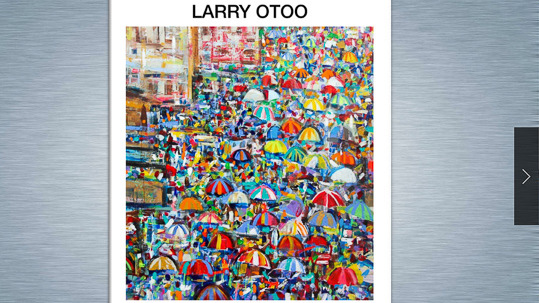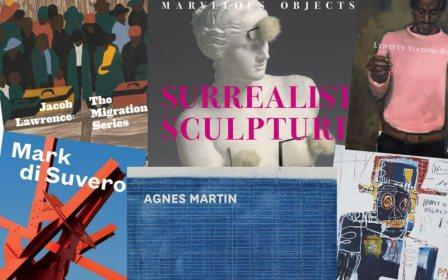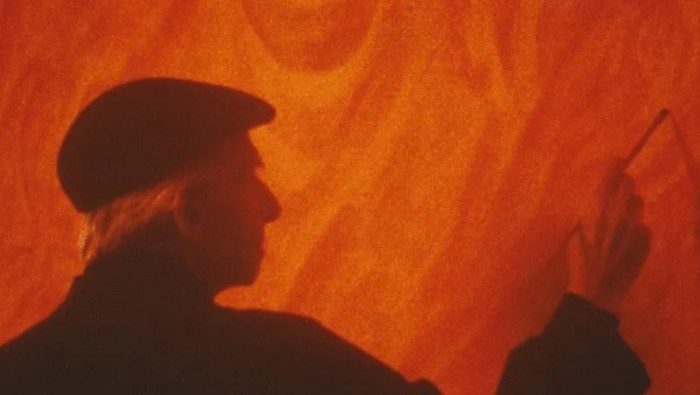In a world in which an American clothing designer’s car collection is exhibited at The MFA in Boston and a major Italian clothier is shown in major museums across the country, painting and sculptor make news when one or another of the top-level auction houses procure what some might consider “silly money” for a Picasso or Johns or Damien Hurst. Happily, whatever the current status of of painting and other fine arts in the art market place and among its practitioners, there continue to be high-quality catalogues and monographs and useful exhibitions on past and present, famous and slightly obscure creators.
The Broad Collection
Edited by Joanne Heyler. Essays by Francesco Bonami, Annie Cohen-Sola, Harry Cooper, Donna De Salvo, Geoff Dyer, John Elderfield, Siri Hustvedt, Pico Iyer, Greil Marcus, Marla Prather, Nancy Princenthal, Luc Sante, Katy Siegel, Franklin Sirmans, Mark Stevens, Greg Tate, Lynne Tillman, and John Waters
Bazillionaires Eli and Edythe Broad, whose art holdings number over 2,000 pieces, founded a museum, The Broad, on Grand Avenue in downtown Los Angeles which opened this past September. The Broad (designed by the renowned architects, Diller Scofidio + Renfrohas) has 120,000 square feet of space on two floors the Broad’s postwar and contemporary art (valued by Forbes at $7.4 billion dollars) collection is exhibited. Naturally, there is a book which introduces the Broad’s well-regarded collection and the history of the Broad’s art philanthropy. Not surprisingly this tome is splendidly illustrated and better yet, contains insightful essays by a number of smart and skillful writers— filmmaker John Waters on Jeff Koons; music critic Greil Marcus on Christopher Wool; novelist Siri Husvedt on Anselm Kiefer; travel writer and essayist Pico Iyer on Takashi Murakami; biographer Mark Stevens on Cy Twombly; and former MOMA curator John Elderfield on Jasper Johns.
Agnes Martin
by Briony Fer, Tiffany Bell, Frances Morris, Agnes Martin
Agnes Martin (1912-2004) was one of the outstanding painters of the 20th century and one of the few women artists in a male-dominated mid-century art subculture. She was a champion swimmer, teacher, car nut, and writer. She also suffered from debilitating bouts of of psychosis. diagnosed as schizophrenia (she heard voices in her head). Born in Canada, she developed what has been labeled as an abstract biomorphic style, influenced by her Abstract Expressionists friends and colleagues. She had her first one-woman exhibition at the Betty Parsons Gallery (Jackson Pollack’s gallerist) in New York in 1958. and moved to New Mexico, where she lived until her death in 2004. As Martin’s significance is once more recognized (an exhibition took place at London’s Tate Museum last summer) a number of books have been issued. Agnes Martin is a useful retrospective survey of Martin’s body of work— early experimental works , her striped and gridded gray paintings and her uses of color in various formats, to her final pieces rife of bold forms as well selection of drawings and watercolors. The scholarly essays contextualize both her work and her relations with her artistic contemporaries.This tome, which at the moment is definitive, is well designed and printed.
Mark di Suvero
by David R. Collens, Nora Lawrence
In case you have not heard of sculptor Mark di Suvero (1933), you should know that his works are exhibited at the world’s most renowned museums and sculpture parks. Given the paucity of scholarship devoted to contemporary sculpture, this tome breaks ground as a comprehensive monograph focusing both on his process and his work, his politics and his devoted advocacy of the arts. Included is a generous selection of works across the breadth of his career, discussions of his choices of settings for his work(urban and pastoral) There are the necessary expository essays and as as well as a wide-ranging interview with di Suvero by artist Ursula von Rydingsvard.
Jean-Michel Basquiat: Now’s the Time
by Dieter Buchhart, Franklin Sirmans, Olivier Berggruen, Glenn O’Brien, Christian Campbell
Almost 30 years after his death, Neo-Expressionist Jean-Michel Basquiat, who was very much the face of the hyperactive 1980s (with Andy Warhol) art scene of New York, the time has come for a less hysterical appraisal (to quote John Berger, “Before you get to him you have to walk through a lot of hot air because he became a local and then an international legend and you have to ignore the screeches of the vultures who deal his work”) of his art. This monograph beautifully reproduces Basquiat’s vividly colorfuland primitivist paintings. When his work was featured in a group show in 1980 he began to receive received critical acclaim for his fusion of words, symbols, stick figures, and animals. His critique of racial justice and tongue-in-cheek social commentary not only secured his own place in the excitable Manhattan art world, it also opened the door for black artists and encouraged the infiltration of street culture into the mainstream. Dieter Buchhar rounds up a useful sampling of art world types— curators, art dealers, and cultural critics (including the ubiquitous, ever astute Glenn O’Brien) to opine on Basquiat’s blooming legacy.
Painting Beyond Pollock
by Morgan Falconer
Art historian and critic Morgan Falconer offers a concise, handy and well-researched survey of the world of painting, post-Jackson Pollock and the Abstract Expressionists of the mid-20th century—from the well established—Willem de Kooning, Agnes Martin, Alex Katz, Ellsworth Kelly, Marlene Dumas, Gerhard Richter, and Brice Marden to the current pantheon, Cecily Brown, Mark Grotjahn, Elizabeth Peyton, John Currin, Neo Rauch, and Mark Bradford as well as some rising stars. Not aiming to be a particularly adventurous or bold critique, Falconer adorns his guide with 260 illustrations. Mostly this is a cheerleading effort as he opines, “Painting offers the chance for sensuous play: it frees us to express, to channel our physical and intellectual selves in ways that ordinary everyday pressures do not.”
Marvelous Objects: Surrealist Sculpture from Paris to New York
by Valerie J. Fletcher
This well-named tome brings together the barely noticed art of sculpture and the great moment of modern art known as Surrealism, which had two main styles—found object formations and natural world biomorphism (shapes reminiscent of nature and living organisms). The focus is European and American Surrealist artists from the early 1920s through the early 1950s.The book offers an accessible introduction to the contributions of European and American Surrealist artists through the mid-20th century—Marcel Duchamp, Man Ray, Salvador Dalí, Hans Bellmer, and Joseph Cornell, Jean Arp, Max Ernst, Henry Moore, and Isamu Noguchi, Alberto Giacometti, Alexander Calder, and David Smith. Author and curator Valerie Fletcher provides an illuminating chronology and exegesis to complement over 200 images and some select historical citations.
Jacob Lawrence: The Migration Series
by Elizabeth Alexander, Leah Dickerman, Elsa Smithgall
Jacob Lawrence, (1917–2000), the best known African-American artist of the 20th century, is celebrated for his Great Migration Series, 60 small tempera paintings with text captions, picturing the mass exodus of black Americans from the rural South to the urban North that began in 1915-16. It was almost immediately exhibited at The Museum of Modern Art (even-numbered panels) and the Phillips Memorial Gallery (odd-numbered panels). Having achieved landmark status, the Great Migration panels will be reunited in exhibitions at The Museum of Modern Art and at The Phillips Collection in 2015 and 2016. The opulent exhibition monograph features short essays on each panel with an overview by MOMA curator Leah Dickerman, and poet Elizabeth Alexander introduces 10 poems commissioned in response to the Migration Series.
New Objectivity: Modern German Art in the Weimar Republic 1919-1933
by Stephanie Barron, Sabine Eckmann, Christian Fuhrmeister
Given events in Germany in the 20th century, one might view Germany’s interwar Weimar Republic (1919-1933) as a bright spot in on otherwise dark horizon and a high point in cultural freedom. Given the social instability, political turmoil, and economic chaos, Weimar artists moved from Expressionism to New Objectivity (Neue Sachlichkeit)—a term fashioned by Gustav F. Hartlaub, director of the Mannheim Kunsthall, who assembled an exhibition in 1925 of the works of the New Objectivists: George Grosz, Otto Dix, Max Beckmann, Georg Schrimpf, Alexander Kanoldt, Carlo Mense, Georg Scholz, and Heinrich Davringhausen. These artists were unsparing in their depiction of the emerging post-Great War society, combining a realistic style with a cynical, critical point of view. This compendium showcases 50 artists with 150 artworks (photography, works on paper, and painting) and is divided into five thematic sections with the obligatory analyses of New Objectivity’s place in art history. This well-produced compilation accompanies LACMA’s exhibition (through Jan. 16, 2016), the first in the U.S. to represent that important artistic period.
Zhang Xiaogang: Disquieting Memories
by Jonathan Fineberg
Chinese artists (including dissident Ai Weiwei) are not exactly household names. So you are to be excused if Zhang Xiaogang (b.1958), one of China’s most important and influential artists, doesn’t ring a bell. His stature is validated by the presence of his art in major museum collections around the world as well the very high prices his paintings command at auction. Now comes the first authoritative monograph on Zhang that serves not only as a catalogue of his surrealist (often) black-and-white paintings—his major works as well as the lesser?known drawings, but also his biography. And the inclusion of never?before?published letters dating from the early 1980s between the artist and his friends not only provides insight into Zhang but is a window to life in the contemporary Middle Kingdom. And as is to be expected the 280 illustrations are well reproduced in a handsomely designed volume.
Max Beckmann at the Saint Louis Art Museum: The Paintings
by Lynette Roth
Thirty-nine of German Neo Objectvist Max Beckmann’s paintings reside at the Saint Louis Art Museum and this volume by Lynette Roth, Harvard Art Museum’s curator, gives these, some of Beckmann’s best regarded images, serious and rigorous examination. This study is dividend six sections—Beckmann’s and the Berlin Secession; his post-World War I life and rise to fame; the role of Parisian art world on Beckmann; living under Nazi rule and his subsequent exile in Amsterdam; his life in the St. Louis art scene of the 1940s; and his relationship with his adopted country, the U.S. The expository sections feature photos and comparative descriptive materials providing a clear appreciation of this significant 20th-century artist.
Yiadom-Boakye
With contributions from Naomi Beckwith, Donatien Grau, Jennifer Higgie, and Lynette Yiadom-Boakye
This relatively slender monograph contains 75 illustrations of London-born and -based painter Lynette Yiadom-Boakye’s (b 1977) delphic paintings. She has emerged internationally as a major talent by way of her large-scale, dazzling portraits, predominantly black, which she has described as “suggestions of people…They don’t share our concerns or anxieties. They are somewhere else altogether.” Yiadom-Boakye’s paintings are distinguished by a dark, muted palette interrupted by burst of brilliant colors. This book is an up-to-date survey of the artist’s career with gorgeous, full-page illustrations. Included are two critical essays, an interview with the artist, and short stories by Yiadom-Boakye that amplify the meaning impact of her paintings.
Night Vision: Nocturnes In American Art, 1860-1960
by Joachim Homann, Avis Berman
Here’s an unusual and original organizing principle— a hundred years of night scenes by American artists from 1860’s introduction of the electric light to the inception of the age of Sputnik—113 images from artists such as Winslow Homer, Georgia O’Keeffe, Andrew Wyeth, Joseph Cornell, Ansel Adams, Edward Hopper, Lee Krasner, Albert Ryder, John Sloan, Alfred Stieglitz, and Andrew Wyeth. This tome catalogues last summer’s exhibition at Bowdoin College Museum of Art organized by its curator, Joachim Homann. A study of how a broad range of American artists in all media met the challenges of creating nocturnal images—he convincingly argues, “…if the current call for a renewed appreciation for the night is heeded..such studies are warranted more than ever as the sanctuary of darkness, long in retreat thanks to the advance of electric light, is increasingly under siege from a whole roster of new technologies…that conspire to make it disappear from our lives…”
Source: http://www.thedailybeast.com
Related Publications
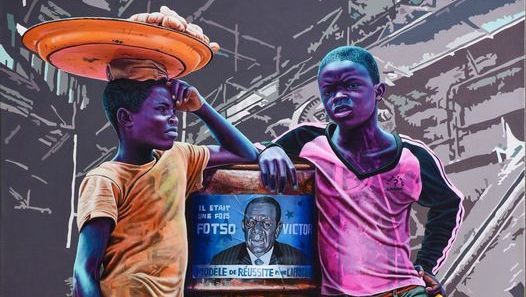
Catalogue "Smiling and Suffering"
June 03, 2022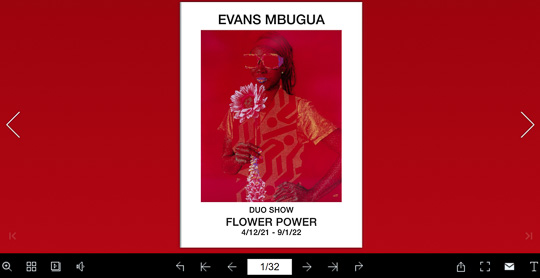
Catalogue Flower Power
December 01, 2021